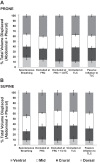Regional diaphragm volume displacement is heterogeneous in dogs
- PMID: 28100474
- PMCID: PMC5402001
- DOI: 10.1152/ajpregu.00270.2016
Regional diaphragm volume displacement is heterogeneous in dogs
Abstract
Muscle shortening and volume displacement (VD) are critical determinants of the pressure-generating capacity of the diaphragm. The present study was designed to test the hypothesis that diaphragm VD is heterogeneous and that distribution of VD is dependent on regional muscle shortening, posture, and the level of muscle activation. Radioopaque markers were sutured along muscle bundles of the peritoneal surface of the crural, dorsal costal, midcostal, and ventral costal regions of the left hemidiaphragm in four dogs. The markers were followed by biplanar video fluoroscopy during quiet spontaneous breathing, passive inflation to total lung capacity (TLC), and inspiratory efforts against an occluded airway at three lung volumes spanning the vital capacity [functional residual capacity, functional residual capacity + ½ inspiratory capacity, and TLC in both the prone and supine postures]. Our data show the ventral costal diaphragm had the largest VD and contributed nearly two times to the total diaphragm VD compared with the dorsal costal portion. In addition, the ventral costal diaphragm contributed nearly half of the total VD in the prone position, whereas it only contributed a quarter of the total VD in the supine postition. During efforts against an occluded airway and during passive inflation to TLC in the supine position, the crural diaphragm displaced volume equivalent to that of the midcostal portion. Regional muscle shortening closely matched regional VD. We conclude that the primary force generator of the diaphragm is primarily dominated by the contribution of the ventral costal region to its VD.
Keywords: chest wall mechanics; modeling diaphragm kinematics; respiratory muscle.
Copyright © 2017 the American Physiological Society.
Figures







References
-
- Amancharla MR, Rodarte JR, Boriek AM. Modeling the kinematics of the canine midcostal diaphragm. Am J Physiol Regul Integr Comp Physiol 280: R588–R597, 2001. - PubMed
-
- Angelillo M, Boriek AM, Rodarte JR, Wilson TA. Shape of the canine diaphragm. J Appl Physiol 89: 15–20, 2000. - PubMed
-
- Angelillo M, Boriek AM, Rodarte JR, Wilson TA. Theory of diaphragm structure and shape. J Appl Physiol 83: 1486–1491, 1997. - PubMed
-
- Boriek AM, Liu S, Rodarte JR. Costal diaphragm curvature in the dog. J Appl Physiol 75: 527–533, 1993. - PubMed
Publication types
MeSH terms
Grants and funding
LinkOut - more resources
Full Text Sources
Other Literature Sources
Medical

